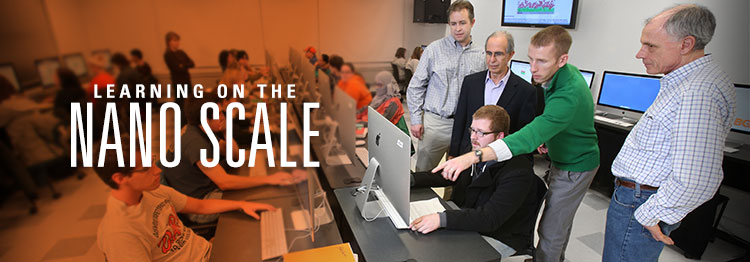Learning on the nano scale
Students grasp concepts with online ‘Constructive Chemistry’

By Bonnie Blankinship
Two containers are displayed side by side on a computer screen, each filled with equal numbers of purple disks representing molecules. The ones in the left container are actively bouncing around, while those on the right remain still.
Dr. Neocles Leontis, a professor of chemistry at Bowling Green State University, attempts to cause the disks on the right to behave like their neighbors by making adjustments such as raising the temperature and decreasing the attraction between the molecules.
Though it looks like a video game, the “Constructive Chemistry” exercise is designed to help students discover basic laws of molecular dynamics for themselves by “playing” with the available variables and seeing the motions of molecules in real time.
Leontis and his BGSU chemistry faculty team members hope the curriculum they are developing around Constructive Chemistry will transform undergraduate chemistry education and dramatically improve both student learning and science teacher preparation. The curriculum will eventually be available free online to educators and students worldwide.
“Research shows that most people will make wrong predictions about how molecules behave based on what they know about large objects like balls and marbles,” Leontis said. “But molecules are nano-sized objects, and physical laws work differently on the nano-scale. Constructive Chemistry gives people a tool to learn about the nano-world by testing their ideas and constructing knowledge for themselves. By allowing students to create meaningful scientific models on their own, they can unlearn their incorrect preconceptions and learn how nature really works on the nano-scale.”
“Using software that allows you to interact with and modify molecular simulations, you can easily test ideas about what governs the behavior of a particular system or property. Sometimes there are surprises,” said Dr. Andrew Torelli, chemistry. “This is especially powerful when students investigate well-known chemical principles and can discover for themselves which parameters have the greatest impact.”
“Students at a higher level can even design their own simulations,” Torelli added. “We start with simple challenges where students create simulations to demonstrate a certain principle. In doing so, they learn which components and parameters must be adjusted to achieve the desired behavior of their system.”
A major advantage of the approach is that working out challenges on a computer is a natural for today’s students. “They live in that world,” Leontis observed.
Funded by the National Science Foundation (NSF), Leontis, Torelli, and BGSU chemistry faculty Drs. Peter Blass and David Erickson are collaborating with Senior Scientist and Molecular Workbench developer Charles Xie of the Concord Consortium, a nonprofit educational research and development organization dedicated to improving education in science, math and engineering through technology. Also part of the partnership is Dakota County Technical College in Minnesota.
Together they are developing curriculum modules for the Molecular Workbench, free online software for anyone to use. With NSF support, the team is making it easier for students to construct their own scientifically accurate simulations to master some of fundamental concepts of chemistry, instead of merely relying on “canned” simulations prepared by experts. They’ve begun with the topics that present the greatest conceptual difficulties in general chemistry, physical chemistry and biochemistry.
“Only by first understanding the fundamental ideas of how atoms and molecules behave can students make sense of more complex ideas in chemistry,” Erickson said.
“It’s surprising to find that even master’s level students often lack a deep understanding of some of the fundamental principles of chemistry,” he noted. “They can repeat the rules but their conceptual understanding is shallow. We’re hoping that this will give them much deeper knowledge. Looking at charts and graphs is one thing, but seeing the principles in motion allows students to visualize what’s happening at the molecular level.”
“We’re really integrating research into teaching,” Leontis said. “We’re taking a ‘scaffolded’ approach to designing the simulations so they’re appropriate for each stage of learning. There are activities with basic elements for beginners and then they become more complex. They’re designed to be engaging and give the freedom to experiment, but not be overwhelming.”
To further strengthen learning, the Molecular Workbench program keeps track of the participant’s actions and creates a mathematical model students can analyze.
With the help of Dakota County Technical College and the Northwest Ohio Center for Excellence in STEM Education ( NWO), located at BGSU, the team is also assessing their curriculum to be sure it is usable and easily teachable to faculty.
An important audience will be science education majors, who will be faced with teaching to new standards and assessments, the team said.
“We think this will strengthen teachers’ content knowledge and increase their confidence,” Erickson said.
“This will also give teachers a free, online tool they can use with high school and even junior high school students,” concluded Leontis.
Updated: 01/25/2019 02:54PM
